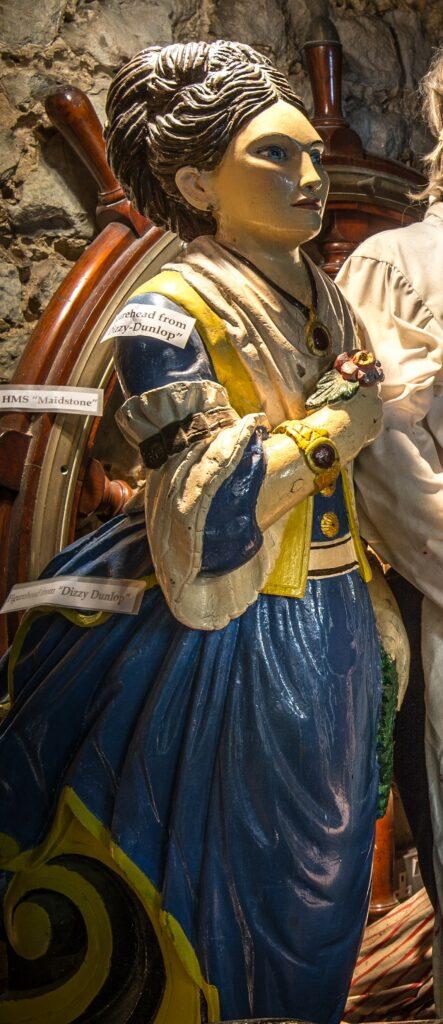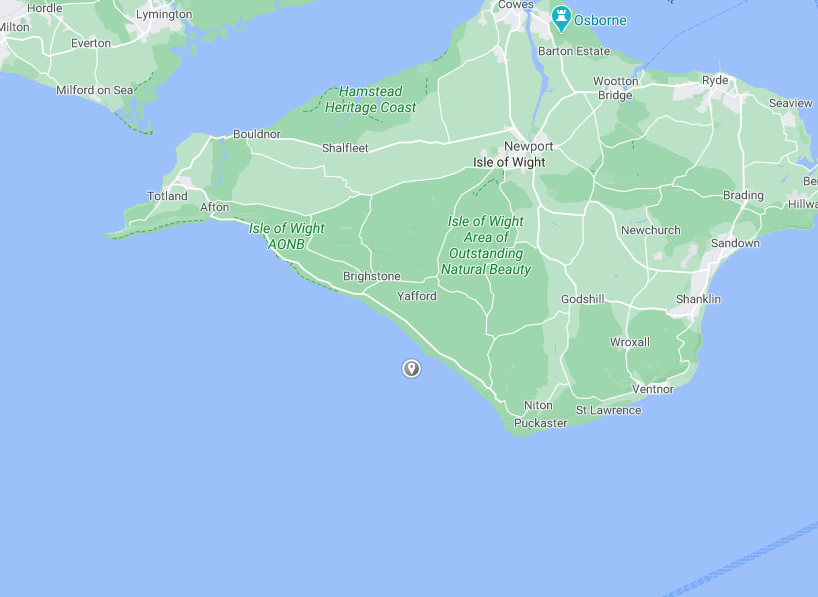
In the 19th century, ships’ figureheads were deemed an essential part of a new merchant vessel, following a decline in the importance attached to them on naval ships. However, the advent of ocean-going steamships in the second half of the 19th century witnessed a gradual decline of figureheads on merchant vessels too. Some have survived, held by a number of museums including the Shipwreck Centre where we have six on display.
One of our figureheads once adorned the Welsh schooner Dizzy Dunlop until it wrecked at Atherfield Ledge. Carved by Sion Edwards of Cricceth, it was intended to represent Mrs Daisy Dunlop, wife of Mr Dunlop of Oakeley Quarry which was one of the premier Welsh slate quarries between 1818 and 1969, exporting slate world-wide from Porthmadog.
The small, 90-ton, wooden schooner Dizzy Dunlop was built at Borth y Gest, Porthmadog in 1878 by a Mr Jones for William Pritchard, 3 Cornhill, Portmadog who, having registered it at Caernarvon on 14 March 1878, owned it throughout its life. The voyage history, derived from the British Newspaper Archive, was mainly from Porthmadog to a wide variety of mainland, Irish and European ports. UK and Irish ports included Southampton, Sunderland, Falmouth, Liverpool, Leith, Galway, Dublin, Runcorn, Ipswich, Irvine, Shields, Newcastle, Burry Port, Waterford, Bantry, Queenstown, Cork, Belfast, Stornoway, Ilfracombe, and London; European ports included Brake, Cuxhaven, Harburg, Hamburg, Stetin, Madeira, Kiel, Finland, Gothenburg, Dunkirk, Nakskov, Aarhuus, and Douglas IoM.

The master for all these voyages was a Mr Williams, except briefly in June 1888, and for the final voyage – on these occasions, a Mr Owen Humphries was recorded as master. Unfortunately, records don’t show the nature of the cargoes carried except in January 1888 when it was carrying barley from Denmark to Cork and for the final voyage when 200 tons of slate was being taken from Porthmadog to Kiel.
The circumstances of the loss are transcribed from the British Newspaper Archive’s Lloyd’s List of 18 April 1890: –
Dizzy Dunlop. —Report of Owen Humphreys, master of the schooner Dizzy Dunlop, of Caernarvon, 98 tons, from Portmadoc, March 21, at 9 a.m., for Kiel, with about 200 tons slates: —Proceeded, all going well until the afternoon of the 6th April. At 1 p.m. that day, tide being ebb, weather very thick, wind S.W., blowing a gentle breeze, with a moderate sea from the S.W., the vessel being then, as far as deponent knows, in the Channel off the Needles, on her course, namely E. by S.½S., the weather still continuing very thick, deponent supposes that the ebb tide catching vessel on the weather bow, must have drifted her up close to where she first struck. About 3.30 p.m., the weather being still very thick, deponent at the wheel and Owen Jones (OS.) on the look-out, the vessel went ashore on the outermost point of Atherfield Ledges. The tide commenced to flow about half-an-hour after, and the force of the sea drove the vessel higher upon the rocks until right across the reef, and about 600 yards from the shore. An anchor was carried out immediately after the vessel stranded, and the crew hove upon it, but without avail. The sails were also backed, but equally in vain. No cast of the lead had been made before the stranding, nor, although intently listened for, was the fog-horn at St. Catherine’s Point heard by anyone on board. Three of the crew were taken ashore in the Atherfield coastguard boat at about 7 p.m., deponent and mate remaining by the vessel until between 10 p.m. and 11 p.m. when they came ashore in the Brixton lifeboat, vessel badly bilged, full of water, and seeing no hope of saving her. —Brixton Coastguard Station (1.W.), April 7
The Dizzy Dunlop became a total wreck, and the cargo was lost. The figurehead was salvaged and subsequently repaired by a local craftsman.
[Article kindly provided by MAT Volunteer Roger Burns]
